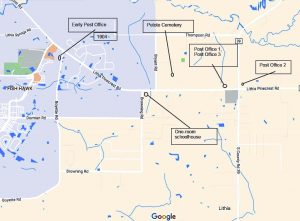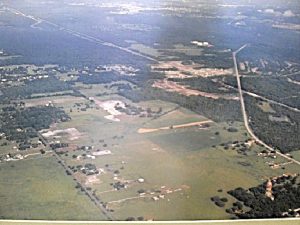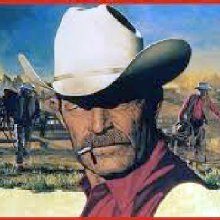The Armed Occupation Act of 1842 brought settlers to central Florida and Eastern Hillsborough County. Under the act, title to 160 acres of land could be obtained by any adult male by constructing a habitable dwelling, cultivating at least five acres, and living on the land for five years. Pre-Civil War economy of the area focused on livestock, sugar cane, tobacco, citrus and vegetables.
Following the Seminole Wars, more settlers moved into the area. James and Roxanna Alderman first forded the Alafia River in 1847 and were Lithia’s first white settlers. Coming from Georgia, even more settlers moved into the area. Between 1860 and 1880 the area became known as Pelote. The Reverend John Pelote was a local Methodist preacher.
The Alderman-Pelote cemetery is still used today.
The area was not intensively settled until after the railroads came to the region. Although a one-room school was built around 1870 and a post office was founded in 1887, real growth came after the railroad connected the area to Tampa. By 1890, Pelote had 180 residents
The Pelote School was founded in 1894 and was located at Pelote cemetery; its connection to the aforementioned school is unknown.
Pelote had a population of 133 residents in 1900 and the local economy involved turpentine, lumber, citrus, and cattle. About this time, Reverend Charles Kingsley moved to the area from Bloomingdale and purchased the land that included Lithia Springs. He sent the water from the spring for chemical testing. The results showed a high concentration of the mineral lithium. Pelote now became Lithia.
In 1904, the post office, after some moves and name changes, was renamed the Lithia Post Office and was situated on the west side of the intersection of the Seaboard Airline Railroad tracks and a dirt road known as Lithia-Pinecrest (the location as shown on the map is at the intersection of Lithia-Pinecrest and Boyette rd).
 (click map to enlarge)
(click map to enlarge)
Lithia-Pinecrest road was first paved in 1923.
My Own Recollections –
My memory of Lithia-Pinecrest road from the 50’s, 60’s and even 70’s was that of a narrow bumpy road with very little traffic. In those early years, you might not see a vehicle but every 30-60 minutes.
Until sometime around the 1980’s, Lithia remained a rural community. With the development of Brandon and Bloomingdale that all changed.
The map above shows the location of the one room schoolhouse. Many area old-timers attended this school. I don’t know when it was closed but for a number of years it was used as a community center. Eventually, the county decided to remove the building and place a fire station on that corner.
Lithia Springs was not very well known to the rest of the county but was frequented by residents of Brandon, Bloomingdale, and Lithia. After traveling the bumpy dirt road leading to the spring, you would often find no more than five or ten people.
The spring was on land owned by Agrico Chemical Co.
There were many agricultural operations at Lithia, including the Blackadar dairy,
Capitano dairy, Stack ranch, and others whose names I have forgotten. A large orange grove fronting Lithia-Pinecrest was partly owned by Al Lopez.

On the above map, you can see Lithia-Pinecrest road snaking its way northeast towards Brandon. You can also see the beginning Fishhawk housing development. The railroad tracks crossed Lithia-Pinecrest at the road’s intersection with Boyette Rd. An occasional train passed by even in the early 60’s.
The good old days are gone but convenience rules; no more driving to Brandon or Plant City for groceries.
__________________________________________________________________________
The old Lithia Community Center, which at one time was the one room schoolhouse. The building was removed to make room for a fire department on the corner of Lithia-Pinecrest Rd. and Browning Rd.

[su_tooltip style=”green” position=”south” shadow=”yes” rounded=”yes” size=”5″ title=”Look” content=”Don’t forget to comment below.” behavior=”always”][/su_tooltip]
4 thoughts on “History of Lithia, Fl.”
Leave a Reply
See you next time




My grandfather, Clem Armstrong, operated a sawmill in Keysville in the 30’s and until shortly after WWII when it burned down. I’m looking for any information about the mill that anyone might be able to share.
Thanks for the comment. Wish I could help you. I first came to Lithia in 1958 so I know little about the earlier history. The people who might know are disappearing fast.
I grew up in Plant City, and still had aunts and uncles in the area of Ft. Lonesome. Almost once a year we had a big family BBQ or picnic at the Alderman’s Ford park, back when it was just a small county park. When we were there, little did I know that James A. Alderman was my great-great-great-grandfather and it was named after him. Nobody ever mentioned it. I didn’t figure it out under just a few years ago when looking at my genealogy. I found out who my Alderman ancestors were, and I came to James A. Alderman. That’s when I found an article and figured it all out. My lineage – Elizzie Jane Alderman Mizell (fraternal grandma), Niram Van Alderman (killed by a Polk Deputy Sheriff in 1920, in a fence cutting incident), Timothy Alderman, James A. Alderman (then back into NC, etc). Elizzie, her mother Cynthia, and Niram Alderman are buried in the Bethlehem Cemetery on Bethlehem Rd. N. of SR674 near Chicora. Timothy is buried in the Mt. Olive Cemetery off of SR37 just N of Bradley Junction. Those folks back then had lots and lots of children. I suppose they had to raise all of their own farm hands. I still remember the old one room school house in Pinecrest. I’ve seen Lithia go from hardly nothing to what it has become. I used to patrol that area as a Hillsborough Co. Sheriff’s Deputy, and know it well. I had to see all the growth overcoming the area.
I saw an article about the Keysville community and the mill recently. I paused for a few moments when writing this and found it only for you:
https://www.ospreyobserver.com/2019/06/keysville-1880-boom-town-second-largest-city-at-one-time/
There are no signs of this left in Keysville today. About all there is down there are rural homes, and not many of them. There used to be a small store at Keysville Rd. and Nichols Rd, but I don’t know if it is there any longer.